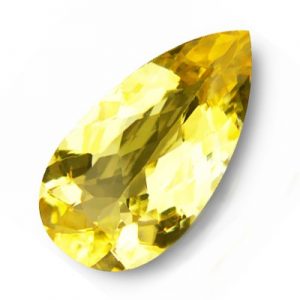Brazilianite
Brazilianite is a rare and beautiful gem with a wonderful lemon yellow color. It was discovered in Minas Gerais, Brazil in 1945. Large crystals are rare and usually kept for mineral collections making gems even harder to come by. Gems are often moderately included and clean gems are very rare. Brazilianite is not very hard by gemstone standards, but it is one of the hardest phosphate minerals. Gems are typically included and large, clean gems are very rare.
Current sources of Brazilianite crystals are Linopolis and Minas Gerais, Brazil; Sullivan County, New Hampshire, USA; Oxford County, Maine, USA; Yavapai County, Arizona, USA; and Rapid Creek area, Yukon Territory, Canada.
| Chemical Formula: | NaAl3(PO4)2(OH)4 |
| Sodium Aluminum Phosphate Hydroxide | |
| Molecular Weight: | 361.91 gm |
| Composition: | Sodium | 6.35 % | Na | 8.56 % | Na2O |
| Aluminum | 22.37 % | Al | 42.26 % | Al2O3 | |
| Phosphorus | 17.12 % | P | 39.22 % | P2O5 | |
| Hydrogen | 1.11 % | H | 9.96 % | H2O | |
| Oxygen | 53.05 % | O | |||
| 100.00 % | 100.00 % | = TOTAL OXIDE |
| Crystallography: | Monoclinic – Prismatic |
| Crystal Habit: | Typically Euhedral Crystals – occurs as well-formed crystals showing good external form. May also be spherical, rounded aggregates or radial fibrous or globular. |
| Twinning: | None |
| Cleavage: | Good on {010} |
| Fracture: | Conchoidal |
| Tenacity: | Brittle |
| Moh’s Hardness: | 5.5 |
| Density: | 2.98 (g/cm3) |
| Luminescence: | None |
| Radioactivity: | Not Radioactive Slowly decomposed by HF and by hot H2SO4. |
| Other: | Slowly decomposed by HF and by hot H2SO4. |
| Color: | Colorless, Greenish yellow, Yellow green, Light yellow |
| Transparency: | Transparent |
| Luster: | Vitreous (glassy) |
| Refractive Index: | 1.602 – 1.623 Biaxial ( + ) |
| Birefringence: | 0.0190 – 0.0210 |
| Dispersion: | Perceptible; 0.014; r < v |
| Pleochroism: | Weak; merely a change in shade of color |


